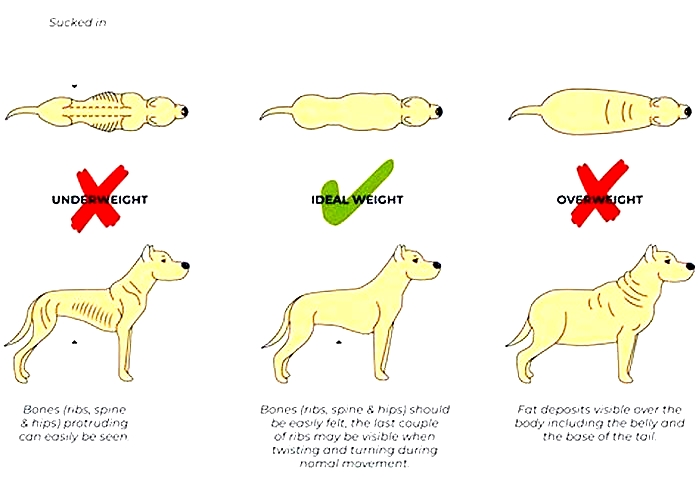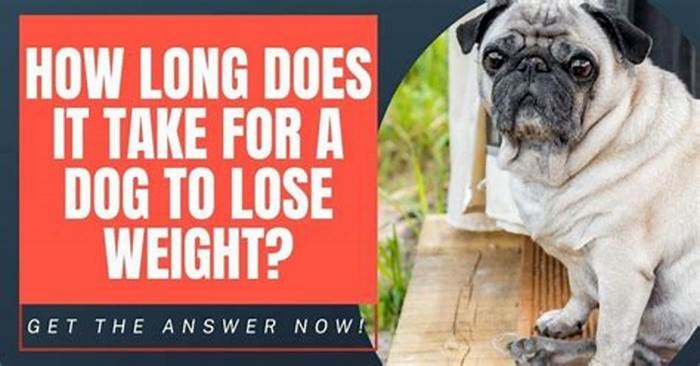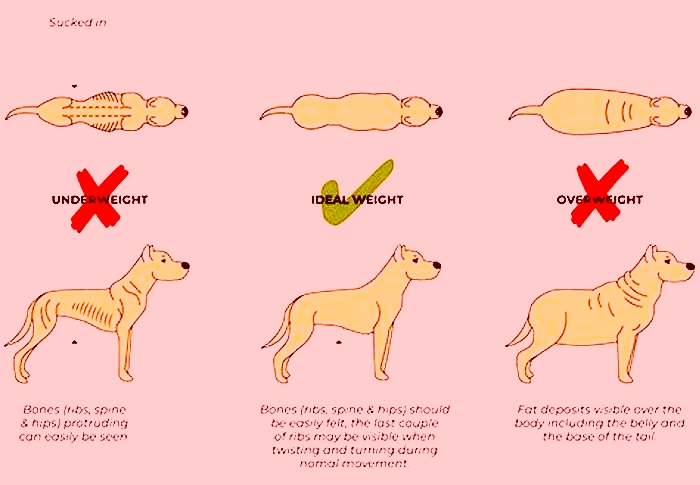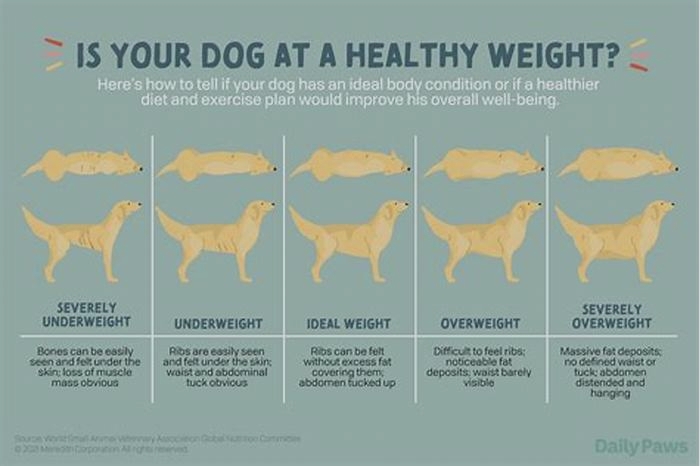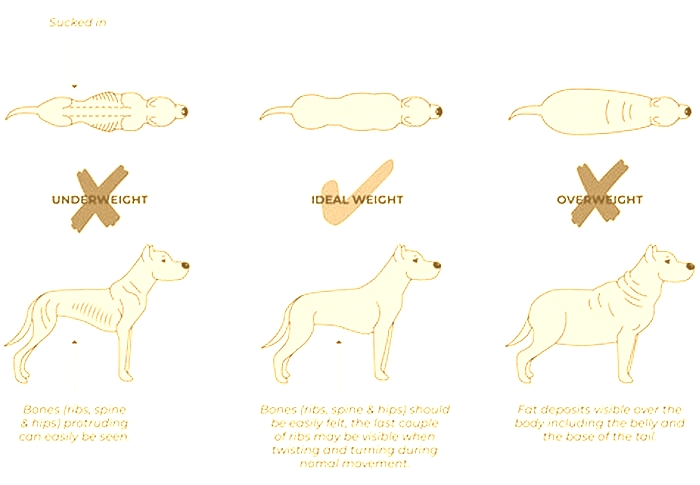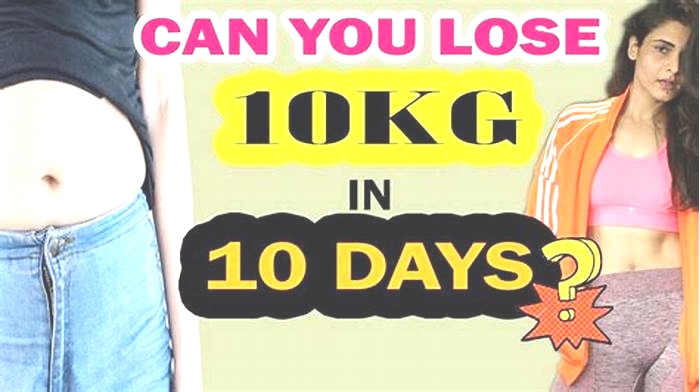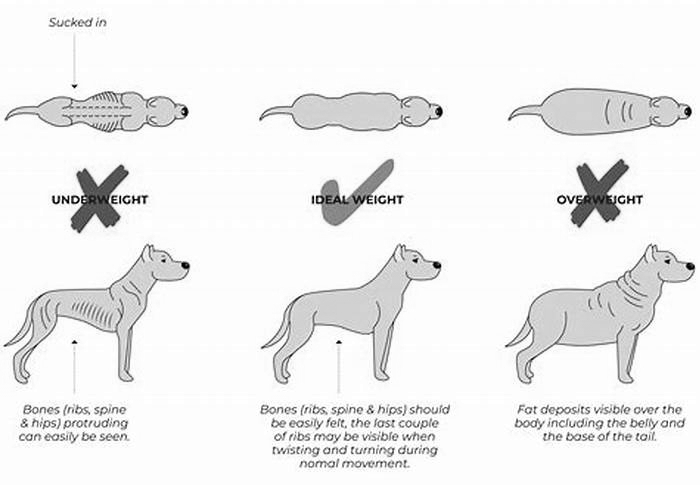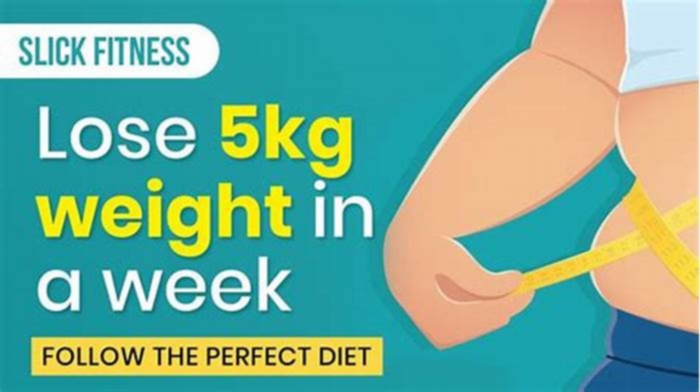Is 2kg a lot for a dog to lose
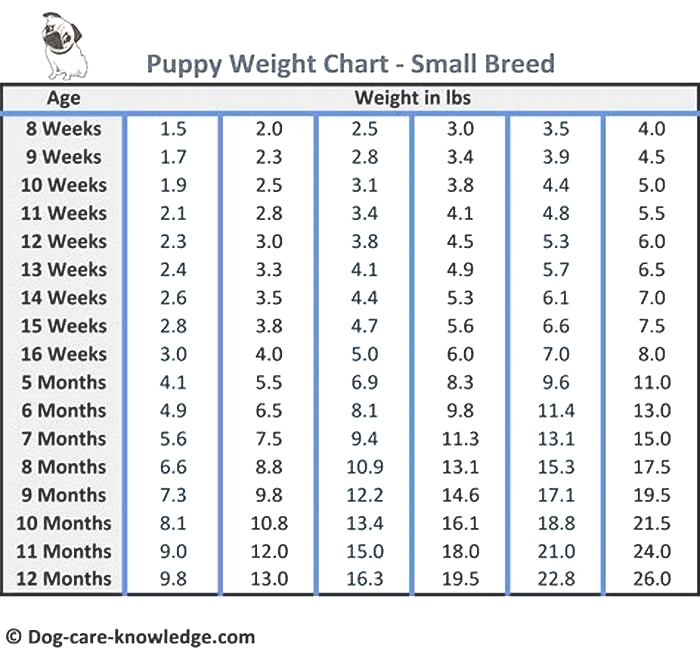
Rapid weight loss in dogs
A gradual loss of weight in a dog is okay and even beneficial if it is expected or there is an obvious reason for it (such as an increase in exercise or a deliberate change of diet). Unexplained rapid weight loss, however, is a concern and should be checked by your veterinarian as soon as you become aware of it.
For example a loss of 2 kg on an average person over a few weeks is generally insignificant. The same amount of weight on a 20 kg dog equates to 10% of their body weight and may indicate an underlying disease process.
What is a healthy weight range for your dog?
There are some useful charts available that are a helpful guide to know the ideal weight for your pet.Click here to view the ideal bodyweight range for your dog by breed.
Please note: there can be significant variation between genetic lines within each breed and it can be difficult to predict the ideal weight of a cross-bred dog due to the presence of 2 or more breeds in its lineage.
The easiest way to assess your dogs ideal weight is to follow a few simple steps:
- Regularly run your hands over your dogs ribs. Can you feel their ribs easily or is there a significant layer of fat over the ribs?
- Observe your dog from above. Can you see a definite waist line or does it blend in to the hips?
- Observe your dog from the side. Can you see a waist line or is there a straight line from the chest to the back legs?
- Weigh your dog at least twice a year (your veterinary clinic will be more than happy for you to use their scales, and we can then record your dogs weight at the same time)
All of the above aspects are jointly used to determine a body condition score (see below diagram). Your veterinary team will be able to advise you on the ideal weight for your dog once the condition score is assessed. As indicated below, the ideal condition score is a 3.
Image supplied by Hill's Prescription Diet ~ Clinical Nutrition to Improve Quality of Life
What should you do if you notice your pet has suddenly lost weight?
As soon as you notice a loss in weight, especially over a short period of time it is important to get your dog checked by your veterinarian.
Some things to think about prior to your visit that may assist your veterinarian in determining the cause of the weight loss include the following questions.
- Has there been any change in your dogs:
- Appetite (increased or decreased)?
- Drinking habits (increased or decreased)?
- Diet (eg changed brand of food, given any food scraps from the table recently, possibility of eating any foreign objects)?
- Faeces (eg any vomiting or diarrhoea)?
- Urination (increased frequency or any difficulty in urinating)?
- Behaviour (eg lethargic, sleepy, restless or hyperactive)?
- Mobility (eg difficulty in walking or getting up after resting)?
- Breathing (eg coughing or wheezing)?
2. When did you first notice the weight loss?
3. Has your dog had access to any toxins?
It is also helpful to know what medications your dog is receiving in regards to the prevention and control of intestinal worms, fleas and heartworm.
Your veterinarian will perform a thorough physical examination of your dog. From the clinical examination and history, a plan can then be formulated for the next step in the diagnostic process. Often a blood, urine or stool sample may be collected to assess your pets internal organs and general health.
Depending on the condition of your pet and the results from any initial diagnostic tests, further treatment and/or tests may be recommended. This could include admission into hospital for intravenous fluids and appropriate medical treatment, and further diagnostic tests such as radiography and/or ultrasonography.
What are some of the causes of rapid weight loss?
Apart from weight loss due to dehydration, rapid weight loss also occurs when your dog has a negative caloric balance. This means that the body is not receiving the necessary calories it needs to maintain a normal weight range. There are several conditions that could cause this including:
- Reduced appetite or intake of calories for some reason (eg severe dental disease can be painful and may prevent your pet from wanting to eat or chew)
- Reduced absorption of calories from the intestine (eg Inflammatory bowel disease can damage the intestinal wall and prevent calories being absorbed into the blood stream)
- Reduced ability to utilise calories due to an underlying medical condition (eg Diabetes Mellitus results in a lack of insulin which means the body is unable to absorb glucose from the blood stream)
- Increased loss of calories (eg vomiting or diarrhoea, renal disease)
- Increased requirement of calories (eg neoplasia)
The examples given are not an exhaustive list of diseases or problems causing rapid weight loss. Your vet will be able to give you more appropriate information and relevant treatment protocols once they have examined your dog and performed the appropriate diagnostic tests.
There are many reasons why a dog can lose weight rapidly so it is important that you take your dog to the vet as soon as you notice unexplained weight loss, as some of these conditions may be serious but many can also be treated successfully, especially if detected early.
It is recommended to visit your vet every 6 months once your dog is aged over 7 years old (which is roughly the equivalent of 50 human years). This allowsfor early detection and treatmentof disease processes that may otherwise lead to weight loss and ill health in your dog.
Helping Your Dog Lose Weight
HELP YOUR DOG LOSE WEIGHT: OVERVIEW
1. Reduce the amount youre feeding gradually every week or two until your dog begins to lose weight.
2. Weigh all the food you feed to give you more control over your dogs diet.Jump to How to Feed Your Dog
3. Monitor your dogs weight regularly to be sure your weight loss program is on track.Jump to Monitoring Your Dogs Weight
4. Watch for calories from treats, chews, leftovers, and other extras that you might not be counting.Jump to Counting Calories
5. Increase exercise gradually as your dog becomes more fit.Jump to How to Exercise Your Overweight Dog
When Ella, a five-year-old Norwich Terrier, first came to live with me a few months ago, she weighed a svelte 10.8 pounds. But within two months her weight had ballooned by almost a full pound, and there was no way you could call her anything but plump.
How could this happen? How could I have let my new dog get fat me, the one who perpetually preaches the benefits of keeping dogs lean? And what the heck was I going to do about it?
The answer is that it happened because Id never owned such a small dog before, and it turned out I was massively overfeeding her, particularly when I counted all the treats she was getting. And I would do whatever it takes to get her back to the weight she should be, and keep her there. Here is what I learned during my struggle to help Ella lose weight.
So What If My Dog is A Little Overweight?
Why worry about one extra pound? On a big dog, one pound wouldnt matter, but for Ella, thats 10 percent of her body weight, and its noticeable on her small frame. But its her health, not her looks, that concerns me.
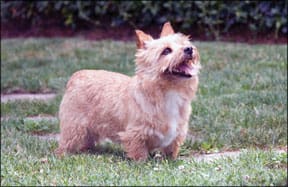
Lean dogs live longer, healthier lives than those who are overweight. A 14-year study showed that dogs fed 25 percent fewer calories than their free-fed littermates lived nearly two years longer and showed fewer visible signs of aging. They also were a full three years older before they needed treatment for arthritis.
Health problems that are more common in overweight dogs include pancreatitis, diabetes, heart disease, disc disease, ruptured cruciate ligaments, hip dysplasia and other forms of joint disease, surgical complications, compromised immune system, and even many forms of cancer.
As many as half of all dogs in the U.S. are overweight, but the majority of their owners are in denial. A recent study found that veterinarians considered 47 percent of their patients to be overweight, yet only 17 percent of the owners agreed. If you cant easily feel your dogs ribs and shoulder blades, her waist is not discernable (a tuck behind the ribs), or theres a roll of fat at the base of her tail, its time to face reality and put your dog on a diet.
Because were so used to seeing overweight dogs, many folks think a dog at his proper weight is too skinny. However, as long as the hips and spine are not protruding and no more than the last rib or two are slightly visible, hes not too thin. If in doubt, ask your vet for an opinion, or go to an agility competition to see what fit dogs look like.
Types of Dog Food Bestfor Weight Loss
Most prescription weight loss diets are excessively high in carbohydrates and low in both fat and protein. The same is true of many commercial weight loss diets, though some companies have recognized that this is not the best way to help dogs to lose weight and have changed their tactics.
Protein and carbohydrates supply the same number of calories, but protein is preferentially used to build lean muscle, while carbs are more likely to be stored as body fat. L-carnitine, an amino acid derivative found in meat, fish, and dairy products, helps to burn fat.
Dogs thrive on high-protein diets and find them more satisfying, while they have no nutritional requirement for carbohydrates. Diets to help your dog lose weight should be high in protein and low in carbs.
Fat has more than twice the calories per gram of protein or carbs, so the amount you feed should be limited. Fat, however, is also what satisfies the appetite best. A diet that is too low in fat will leave your dog feeling hungry all the time, making it harder for you to stick to the diet plan and potentially leading to food-stealing or even poop-eating. Its better to feed a diet with moderate fat and reduce the portion size as needed rather than feeding a low-fat diet.
If you are feeding kibble or other dry food, look for a minimum of 25 percent protein. More is better: generally, the higher the protein, the lower the carbs. There is no harm in feeding high protein diets to puppies, seniors, or healthy adult dogs; there are only a few specific health conditions that require protein to be limited. (See Diet and the Older Dog, WDJ December 2006, for more information on this topic).
Look for fat percentage around 12 to 16 percent. Some dogs have had success losing weight with reduced portions of even higher-fat foods that are also very high in protein, probably because these foods are quite low in carbs.
Avoid foods with excessively high (more than 5 to 6 percent) fiber, the indigestible part of carbohydrates. Increased fiber will not help your dog feel satisfied, and too much can interfere with nutrient absorption. Hills Prescription r/d dry dog food (its weight-loss formula) has an astonishing 26 percent fiber, including 10.4 percent cellulose (essentially sawdust!). Over one quarter of what youre paying for is indigestible.
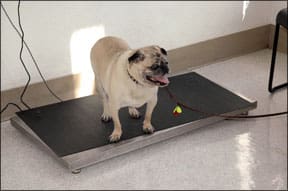
Examples of good food choices include Wellness CORE Original (34 percent protein, 14 percent fat, 4 percent fiber) and Orjijen Adult (40 percent protein, 16 percent fat, 2.5 percent fiber).
For canned foods, subtract the moisture percentage from 100, then look for protein that is at least one third the remainder, and fat that is one quarter the remainder or a little less. Usually that means protein is at least 8 percent and fat is around 5 to 6 percent, but these values may be slightly lower for foods with very high moisture content (80 percent or more).
Many (though not all) grain-free foods are high in protein and low in carbs, though a number of them are also high in fat. The majority of senior and light diets are still high-carb and low-protein. However, a number of newer formulas now use higher protein (which means fewer carbs), and are lower in fat than adult maintenance foods. Canned foods are usually higher in protein and lower in carbs than dry foods.
If you feed a homemade diet, feed lean meats, low-fat dairy, and green vegetables in place of most grains and starches. Remove the skin from poultry, but feed the dark meat rather than very low-fat breast meat. Remove separable fat from meats, and avoid fatty meats such as lamb, pork, and high-fat beef, or cook them to remove most of the fat. Its okay to include eggs in the diet in moderate amounts. You can also use these foods to replace part of a commercial diet, which will increase the amount of protein and decrease the amount of carbs in the overall diet.
How Should You Feed Your Dog?
Reduce the amount you feed gradually rather than making drastic changes all at once. Cutting the amount of food too dramatically will change your dogs metabolism, making it harder to lose weight and easier to gain it back. Slow, steady weight loss is more likely to result in long-term success.
If you continue to use the same food youre feeding now, start by reducing the amount by about 5 per cent, or around 1 ounce per pound of food, or 1/8 of a cup per two cups of food, depending on how you measure what you feed. Weigh your dog in one to two weeks. If your dog has not lost weight, reduce the amount of food by another 5 per cent. Continue to reduce the amount of food you feed every week or two until your dog begins to lose weight, then continue feeding that amount.
If you switch to a new food that is considerably higher in protein and fat than your current food, cut the quantity of food by up to one third, as these foods are more nutrient dense and will provide more calories in smaller portions. Even though the total amount of food your dog gets is less than before, you may find he is more satisfied.
Its critical to accurately measure the amount of food that you feed. I learned the hard way that when I try to eyeball my dogs food, they gain weight. The only way Ive found to achieve consistent weight control is by using an electronic postal scale to weigh everything I feed. You can find these scales at office supply and kitchen supply stores, department stores such as Target, and online at places like Amazon. Most can handle up to five pounds with accuracy to the tenth of an ounce, and will also allow you to switch to grams when needed for more accuracy with very small measurements.
Monitoring Your Dogs Weight
You must weigh your dog frequently, especially when first starting a weight-loss program. Aim for weight loss of 3 to 5 percent of body weight per month, or one percent per week. A 50-pound dog should lose about half a pound per week, or 2 pounds per month.
Because Ella is so small, I couldnt get an accurate weight by picking her up and weighing us both on my bathroom scale, then subtracting my own weight. Instead, I bought a shipping postal scale that weighs up to 55 pounds. I put a box on the scale and zero it out, then put Ella in the box to measure her weight to the nearest half ounce (a small treat afterward makes her a willing participant).
If your dog is too heavy to pick up, youll need to go to your veterinarians office in order to get an accurate weight. This is also a good time to help desensitize your dog to vet visits, by feeding small bits of low-calorie, high-value treats while youre there.
Once your dog begins losing weight steadily, you can go longer between weigh-ins, but recheck at least monthly to make sure youre still on the right track. Its easy to slip back into giving too much food and undo much of the good youve done if you rely solely on how your dog looks and feels. By the time you notice a difference, your dog could have gained a lot of weight back. Caloric needs can also change over time as your dog ages, after neutering, or if his activity level varies seasonally. If youre weighing your dog regularly, youll be able to catch any weight gain early and react before you have a bigger problem.
How to Count Calories: Not As Difficult As You Might Think
Resting energy requirement (RER) is the number of calories per day your dog requires for just basic needs, and a good amount to feed most dogs to encourage weight loss. To determine your dogs RER, convert his ideal weight in pounds to kilograms by dividing by 2.2, then multiply that number by 30 and add 70.
For Ella, I used 10 pounds as her ideal weight,which is 4.5 kg, multiplied by 30 is 135, plus 70 is a total of 205 kcal/day. This is what I should feed in order to help her lose weight.
This amount may need to be adjusted in some cases. Dogswho are substantially overweight may do best with an interim target weight to start with. Very active dogs may require up to 1.4 times their RER to keep weight loss at a safe rate of no more than 5 percent per month.
Heres another approach: 3,500 calories = one pound ofweight. If your goal is for your dog to lose one pound every two weeks (appropriate for a dog who should weigh 50 pounds), you must reduce calories by 3,500 pertwo weeks, or 250 calories per day.
An even easier method to arrive at the same result is to multiply your dogs ideal weight by 5, then reduce dailycalories by that amount. For a dog that should weigh 50 pounds, 50 times 5 is 250 calories per day, the same amount calculated above.
Calorie Calculators
Many calorie calculators signicantly overestimate the calories most non-working, neutered dogs need (as do the feeding recommendations on many dog food labels). One calorie calculator I found said Ella shouldbe getting up to 400 kcal per day, but when I researched this further, I discovered that my goal should be closer to 200 kcal if I wanted her to lose weight, and likely no more than around 270 kcal to maintain her ideal weight. Remember to use your dogs ideal weight, not his currentweight, to estimate caloric needs.
How Many Calories is Your Dog Eating?
NutritionData.com provides the number of calories in a variety of human foods. They offer several serving sizes, but you may have to do further calculations to match what you feed. For Ella, I converted most foods to kcal per ounce, but used kcal per item for things like eggs and treats. If NutritionData.com doesnt offer a portion size in ounces, divide kcal per 100 grams by 3.5 to get kcal per ounce. Beware of volume measurements, such as kcal per cup, which will not be as accurate as measuring by weight.
I also feed raw meaty bones and some commercial dog foods and treats that arent listed at NutritionData.com. Forthe raw meaty bones, I used a variety of sources to get an idea of how many calories they contain. For the commercial foods and treats, I looked on the packaging, product websites, or contacted the companies to nd out how many calories each contained. See below for my discoveries in Calories in Selected Foods and Treats.
Keep in mind that the foods you feed may vary in calorie content from those shown in the chart. Always check the labels of packaged foods to verify the calories they provide. See belowfor how to convert those values to match the amount you feed.
Measurement Conversion and Calculation
To convert pounds to kilograms, divide by 2.2. A dog who weighs 11 pounds also weighs 5 kilograms (11 + 2.2 = 5).
To determine your dogs resting energy requirement (RER), or kilocalories each day, multiply your dogs ideal body weight in kilograms by 30 and add 70. For example, if 5 kg is Ellas ideal weight, then she should receive around 220 kcal per day (30 x 5 = 150 + 70 = 220); this amount should help her lose weight until she attains her ideal weight.
To convert kcal/100 grams to kcal/oz, divide kcal/100 grams by 3.5. For example, if white rice has 130 kcal per 100 grams, it has 37 kcal per ounce.
To convert kcal/kg to kcal/oz, divide by 35. For example, if raw ground beef with 10 percent fat has 1,760 kcal/kg, it has 50 kcal/ounce.
To convert kcal/lb to kcal/oz, divide by 16. If Primal Beef Grind has 1,226 kcal/lb, it has 77 kcal/oz.
To convert kcal/kg to kcal/gram, divide by 1,000. If one scoop of The Honest Kitchens Preference weighs 8 grams (a little over % ounce) and Preference has 3,510 kcal/kg, divide 3,510 by 1,000, and then multiple by 8 to get 28 kcal per 8 gram scoop.
Dog Treats for Overweight Dogs
When Ella continued to gain weight even with reduced meals, I realized that I needed to consider the calories she was getting from treats, particularly since, like any new dog, she needed a lot of training.
I used treats to reward behaviors that I wanted to encourage, such as pottying outside and learning to use the dog door. I fed her cooked chicken breast to counter-condition her shyness around strangers that we met on our walks. I put treats in a Kong toy when I left the house, to reduce any anxiety she might feel about being alone. I used clicker training to improve our communication. Altogether, those treats added up to a lot of calories.
Dogs care more about the number of treats they get than the size of each treat: its more rewarding for a dog to receive several small treats than one big one (dogs dont generally savor treats; both a tiny treat and a larger treat take only about a second to swallow!). Using small treats allows you to reward your dog without adding too many extra calories.
For a dog Ellas size, this means using really tiny treats. I cut already small Zukes Minis into four pieces and a single Zukes Jerky Naturals into 25 to 30 pieces to use for clicker training.
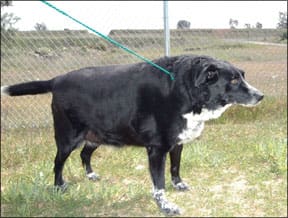
Avoid treats that are high in fat and calories, such as cheese, hot dogs, and peanut butter. Raw vegetables and some fruits make excellent treats. I give baby carrots to my small dog. Broccoli, celery, zucchini slices, or any other crunchy vegetable your dog likes can be used, as can small slices of fruit such as apple, banana, and melon. Dont feed grapes or raisins to dogs, though, as these can be dangerous to their health.
You can make your own treats out of low-fat meats such as heart and liver. Add anise seed for a flavor that dogs love. Never use xylitol, a lower-calorie sugar substitute used in baking that can be fatal to dogs.
Feeding part of your dogs meals as treats is another option, but be sure to reduce the meal size accordingly.
Remember that affection and exercise can be used to reward your dog and show your love. Going for a walk, playing a game of tug, and throwing a ball are great substitutes for treats.
Dont Forget Dog Chews
Ella loves to chew, and she surprised me by completely consuming smaller chews, such as dried tendons and steer sticks, in a single session. But when she found a 12-inch bully stick that my old dog had left behind, it lasted almost two months, even with her working on it every night. This provided chewing pleasure without adding a lot of calories.
Avoid chews that are high in fat, such as pig ears, and look for chews that last your dog a long time. Bully sticks (or the thinner steer sticks, for dogs who are less aggressive chewers) are mostly protein with little fat. Himalayan dog chews are made from yak and cow milk and have less then 1 percent fat. Deer antlers are another low-fat, long-lasting option. If you use rawhide, look for high-quality, thick, unbleached or lightly bleached (not white) rawhides without added flavorings or smoking, made from one solid piece, and preferably made in the U.S., such as those made by Wholesome Hide. (See Finding the Right Rawhide, May 2009, for more information on how to choose healthy rawhide chews.)
Fresh bones can also be used for chewing. Bones, like any hard chew, have the potential to break teeth, particularly in older dogs whose teeth are more brittle. Bones such as knuckles, however, that are too big for the dog to get between their molars and chomp down on, are less likely to cause problems than marrow bones, which are also filled with fat and therefore not a good choice.
Here are the calorie calculations I made for many of the foods and treats I give Ella, along with the calories in some common supermarket treats.
| FOOD | ORIGINAL MEASURE OF KCAL | KCAL |
| COMMON INGREDIENTS IN HOME-PREPARED RAW DIETS | ||
| Chicken necks (skinless) | 535-745/lb. | 33-47 per oz. |
| Chicken necks w/ skin | 910-1,212/lb. | 57-76 per oz. |
| Chicken backs w/ skin | 944/lb. | 59 per oz. |
| Turkey necks (skinless) | 527-613/lb. | 33-38 per oz. |
| Chicken breast (skinless) | 110-165/100 grams | 31-47 per oz. |
| 1 Egg | Small, Medium, Large | 54/63/71 per egg |
| Ground beef, raw (10% fat) | 1,760/kg | 50 per oz. |
| Ground beef, raw (15% fat) | 2,150/kg | 61 per oz. |
| Ground beef, raw (20% fat) | 2,540/kg | 72 per oz. |
| Pink salmon | 1,375/kg | 39 per oz. |
| Sardines | 94-200/100 grams | 27-57 per oz. |
| Plain yogurt | 120-173/8 oz. | 15-22 per oz. |
| White rice | 130/100 grams | 37 per oz. |
| HIGH-QUALITY COMMERCIAL DIETS w/ WHOLE FOOD INGREDIENTS | ||
| Country Pet (all) | 3,840/kg | 109 per oz. |
| Primal Beef Grind | 1,226/lb. | 77 per oz. |
| Primal Chicken Grind | 794/lb. | 50 per oz. |
| Primal Turkey Grind | 735/lb. | 46 per oz. |
| Primal Turkey Mix | 654/lb. | 41 per oz. |
| Primal Lamb Formula | 1,194/lb. | 75 per oz. |
| The Honest Kitchens Preference | 3,510/kg | 100 per oz. |
| HIGH-QUALITY COMMERCIAL TREATS | ||
| Zukes Mini Naturals | 2 per treat | 2 per treat |
| Zukes Jerky Naturals | 17 per piece | 17 per piece |
| Charlee Bear Treats | 3 per treat | 3 per treat |
| Itty Bitty Buddy Biscuits | 3.4-3.5 per treat | 3.4-3.5 per treat |
| Liver Biscotti | 1 per treat | 1 per treat |
| Redbarn Bully Sticks | 29 per inch | 29 per inch |
| COMMON SUPERMARKET TREATS | ||
| Milk-Bone Biscuit | Small/Medium/Large/X-Large | 10/40/115/225 per treat |
| Pedigree Dentabone | Small/Medium/Large | 105/188/300 per bone |
| Purina Busy Bone | Small/Large | 309/600 per bone |
| Flavored rawhide | 283/100 grams | 81 per oz. |
Extra Calories Your Dog Might Get
Ive always shared my food with my dogs, giving them a little bit of anything good for them when Im done (never while eating, as that rewards begging). I realized this was another way that Ella was getting extra calories, particularly since I was used to sharing with larger dogs and was giving her too much.
Share only foods that are not high in fat, and keep portions small. If your dog gets extra people food, cut back on his next meal to help balance things out. Make sure other family members understand how important it is to control the amount of food that your dog gets so they dont subvert the process. Watch out for visitors and neighbors who may be feeding your dog snacks you dont know about.
Could your dog be eating the cats food (or worse, raiding the cats litterbox)? Keep cat food up high and the litter box behind a baby gate where the dog cant reach it. If your dog raids the garbage, get a locking can, cabinet locks, or a motion-activated alarm to keep him out of the trash.
Try writing down every piece of food that your dog gets in a week, including from other family members. You may be surprised at what you find.
How to Exercise Your Overweight Dog
Regular exercise is also an essential component of a successful weight-loss program. Proper exercise not only burns calories, but also helps to convert fat into muscle, improving body condition. As your dog loses weight and gains muscle, he will become more active, which will further speed up the process.
If your dog is a couch potato, dont try to do too much too soon. Start with very short sessions tailored to your dogs capabilities, such as on-leash walks that gradually lengthen as your dogs exercise tolerance increases. Safe areas where your dog can run off-lead will provide even more benefit.
Moderate exercise is good for dogs with arthritis, as muscles help to hold the joints in place and reduce the amount of wear, but dont exercise your dog to the point where he is sore afterward. Non-weight-bearing exercise, such as swimming, is ideal for dogs with joint problems, and for other dogs as well. Again, start slowly, using a dog life jacket if that helps him to feel more comfortable in the water.
Chasing a ball is great exercise, but sudden stops and turns can be hard on joints, so dont overdo games of fetch, especially while your dog is still overweight. Remember to keep sessions short until hes in better shape.
If your dog is older or has health problems, consult with your veterinarian before beginning an exercise program. If your dog really doesnt want to exercise, it could be a sign that somethings wrong. A trial of pain medication can help you figure out whether your dogs lack of activity is related to discomfort.
Ella is athletic despite her small size. We walk two miles every day, and she gets more strenuous exercise chasing her lure: a real raccoon tail (from cleanrun.com) tied to the end of a lunge whip. At least I was doing something right.
Making Sure Your Dog Feels Satiated
Theres a common misconception that replacing a large portion of the diet with green beans will help your dog not feel hungry. While theres no harm in adding some green beans or other non-starchy veggies to your dogs diet, the extra bulk wont help your dog feel satisfied if youre feeding too few calories or too little fat. It is fat that helps the most to satiate your dog; just adding bulk isnt enough. Replacing too much food with green beans can also lead to protein deficiency, causing loss of lean muscle rather than fat.
Feed smaller portions more often to help your dog not feel hungry. Replace some dry food with canned or fresh, high-protein food so he thinks hes getting something special. Put all his meals in a Kong, Buster Cube, or other food-dispensing toy so he has to work for them, leaving him feeling more satisfied. Freeze his wet food, or dry food mixed with nonfat yogurt, in a Kong toy to make a meal last even longer. Give long-lasting chews and low-calorie treats such as carrot sticks to prevent your dog from feeling deprived.
Exercise will distract your dog from focusing on food and relieve stress that can drive some dogs to overeat.
If your dog acts very hungry but is losing weight slowly or not at all, then try changing foods. A diet that is higher in protein and possibly fat, particularly if youre currently feeding a low-fat or low-protein diet, will help your dog feel satisfied with fewer calories.
Diet Aids for Dogs
In 2007, the FDA approved Pfizers Slentrol (dirlotapide), a drug that suppresses the appetite and blocks fat absorption. If your dog is severely overweight and you just cant make the changes needed to help him lose weight, or you need to get weight off very fast due to an orthopedic emergency or similar situation, this drug may be an option, but its not a substitute for proper diet and exercise. The safety of Slentrol has not been evaluated beyond one year. Once you stop the drug, your dog may regain all the weight he lost even with continued reduced caloric input. Slentrol is also quite expensive.
Many supplements are touted for helping people lose weight without dieting or exercise, but none have proven to be both safe and effective. There is no way to know if weight loss supplements sold for people are safe for dogs. Some common ingredients, such as caffeine, are dangerous for dogs. To be safe, avoid supplements that claim to help with weigh loss, and stick to the tried and true: diet and exercise.
What If Your Dog Cant Seem to Lose Weight No Matter What?
If youve done everything recommended and your dog still is not losing weight, or if you have to feed even less than your dogs Resting Energy Requirement (RER) to achieve weight loss, have your vet check your dog for underlying health problems.
Hypothyroidism can lead to weight gain despite consuming few calories. Both diabetes and Cushings disease can cause increased appetite and weight gain accompanied by excess thirst and urination. In rare cases, a tumor of the pancreas called an insulinoma can also cause increased appetite.
My Chubby Little Dog
Yes, it sounds funny to say my dog is pleasingly plump, or cute and cuddly, or any of the other euphemisms we use to describe our overweight pets, but the health risks from Ellas extra weight are real. Ella is now losing one to two ounces per week, a steady, gradual weight loss that should soon return her to her original weight. I weigh her every week, and continue to cut back on the number of treats and extra food she gets if she hasnt lost any more.
I have no doubt that Ella will reach and maintain her ideal weight, as I am determined to do everything in my power to ensure that she leads a long and healthy life. I love her too much to let her suffer from all the problems caused by being overweight.
In memoriam: Marys dog Piglet passed away peacefully in March at the age of 17. Controlling her weight kept her mobile to the end, despite severe degenerative joint disease in both elbows.
Mary Straus does research on canine health and nutrition topics as an avocation. She is the owner of the DogAware.com website. She and Ella live in the San Francisco Bay Area.

